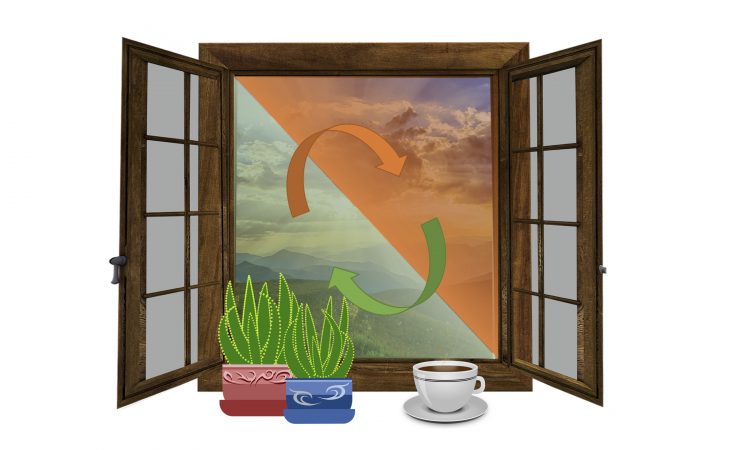Featured image adapted from Pixabay under CC0.
| Title: | Warm/cool-tone switchable thermochromic material for smart windows by orthogonally integrating properties of pillar[6]arene and ferrocene |
| Authors: | Sai Wang, Zuqiang Xu, Tingting Wang, Tangxin Xiao, Xiao-Yu Hu, Ying-Zhong Shen & Leyong Wang |
| Publication Info: | Nature Communications, 2018, 9, 1737 DOI: 10.1038/s41467-018-03827-3 |
Any HGTV addict (House Hunters, anyone?) knows that choosing the right home can be a riveting decision: your future happiness could hinge on those marble countertops or high ceilings! But for the rest of us, don’t despair: chemistry is here with a new smart window coating guaranteed to lift your mood!
A recently-published study in Nature Communications demonstrates a material (Fc-gel-EGP6) that serves double duty as a smart window coating. Not only does the coating transmit less IR light at higher temperatures, keeping your home cool in the summer— it can also transition from cool color tones in the hot summer to warm color tones in the dark and cold of winter.

Fc-gel-EGP6 is fundamentally a composite of a thermoresponsive polymer, ethylene glycol-modified pillar[6]arene, and a redox-active molecule, ferrocene, attached to a second polymer composed of polyacrylamide (Figure 1). When the two polymers are mixed, the ferrocene molecules nest inside the cylindrical structure of EGP6 (Figure 2) in a process called host-guest complexation.

An electric potential applied to the composite – perhaps by a switch at the edge of your window – oxidizes ferrocene to ferrocenium and gives the window a greenish tint (Figure 3).

For those of you who don’t remember your Pantone color wheel, “cool tones” include green, blue and purple, while “warm tones” are red, orange and yellow. Research in the social sciences has shown that different colors of light can affect your emotions and mood; light therapy is already being used as a treatment for that classic winter malady, seasonal affective disorder (SAD).1 A single molecule like ferrocene, absorbing a limited range of light, might not offer the color tones to perfectly complement your wallpaper; however, ferrocene does absorb blue light, which heightens your emotional response to stimuli.1
So far, the Fc-gel-EGP6 coating has only been tested for approximately one hundred cycles of temperature and of electric potential, so don’t expect to see these windows on homes just yet! But the chemistry underlying this novel technology may someday be keeping your home cool— and your emotions even cooler.
References:
(1) Vandewalle, G.; Schwartz, S.; Grandjean, D.; Wuillaume, C.; Balteau, E.; Degueldre, C.; Schabus, M.; Phillips, C.; Luxen, A.; Dijk, D. J.; et al. Spectral Quality of Light Modulates Emotional Brain Responses in Humans. Proc. Natl. Acad. Sci. U. S. A. 2010, 107 (45), 19549–19554.

